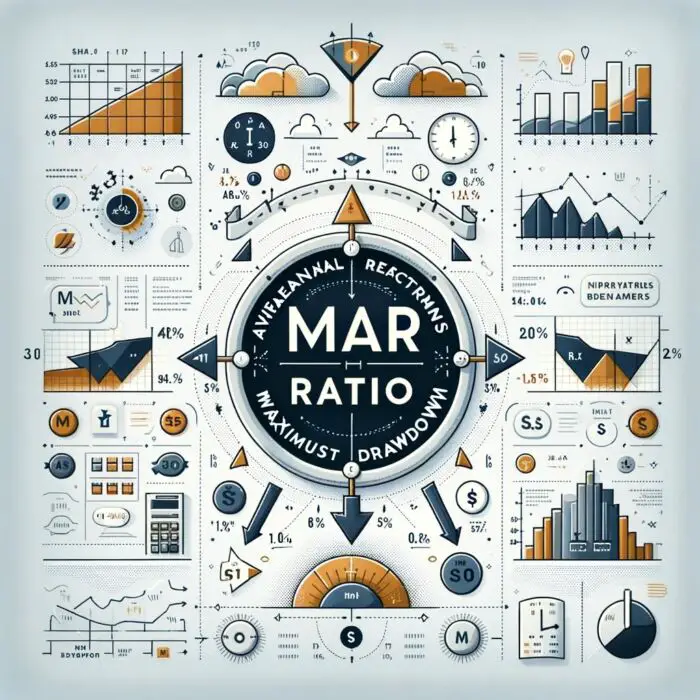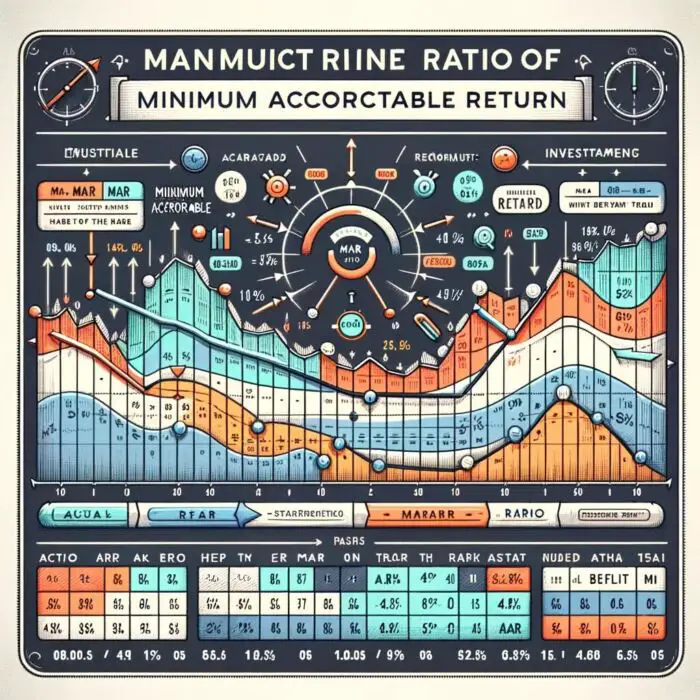In the ever-evolving landscape of investment, one metric stands out as an indispensable tool for discerning investors seeking to navigate the tumultuous seas of financial markets – the MAR Ratio. An enigma to some and a compass to others, this ratio offers a profound insight into the world of risk-adjusted returns, an aspect of investing that often separates the triumphant from the hapless. In this article, we embark on a journey to decode the MAR Ratio, exploring its intricacies, relevance, and application in contemporary investment strategies.
source: Roger Scott on YouTube
Definition of the MAR Ratio
Before we embark on this expedition, it is imperative to grasp the fundamental premise of the MAR Ratio. An acronym for “Minimum Acceptable Return,” the MAR Ratio is an elegant measure that articulates the delicate balance between returns and risk. At its core, it endeavors to answer a pivotal question that resonates deeply with every investor: What is the minimum level of return one should expect, given the risks assumed within an investment portfolio?

Importance of Risk-Adjusted Returns in Investing
In a world where the investment universe teems with choices, ranging from traditional assets like stocks and bonds to the exotic allure of cryptocurrencies and alternative investments, the quest for superior returns often obscures a paramount consideration – risk. Risk, in the realm of investments, is an omnipresent companion, capable of both elevating and undermining financial fortunes. It is here that risk-adjusted returns take center stage, serving as a beacon to illuminate the path to prudent investment decisions.
The quest for higher returns can lead investors into treacherous waters, where the allure of outsized gains may blind them to the perils lurking beneath the surface. In such a scenario, the MAR Ratio acts as a guiding light, illuminating the trade-offs between risk and reward, offering a nuanced perspective that goes beyond mere returns.

Purpose and Structure of the Article
The purpose of this article is multifaceted. First and foremost, it seeks to demystify the MAR Ratio, rendering it accessible to both novice and seasoned investors. By the journey’s end, every reader will be armed with the knowledge to comprehend, calculate, and apply this ratio effectively.
Furthermore, this article aims to underscore the profound importance of considering risk-adjusted returns as an integral facet of investment decision-making. It is not merely an esoteric metric for financial theorists but a pragmatic tool that can shape the financial destinies of investors.
In the subsequent sections, we shall delve deeper into the MAR Ratio, uncovering its intricacies and exploring real-world applications. Through illustrative case studies, practical applications, and strategies for enhancing the MAR Ratio, we hope to equip investors with a powerful tool for making informed investment choices in a world where the tides of risk and return forever surge.
With this foundation laid, let us embark on a voyage into the heart of the MAR Ratio, unraveling its secrets and arming you with the knowledge that every discerning investor needs.

Understanding the Basics of the MAR Ratio
What Does “MAR” Stand For?
To embark on a meaningful exploration of the MAR Ratio, we must first unravel the acronym itself. “MAR” stands for “Minimum Acceptable Return.” This concept encapsulates the idea that investors, regardless of their risk tolerance or financial objectives, possess a threshold below which returns are deemed unacceptable. It’s an intrinsic measure of expectation and prudence in the world of investments.
At its essence, the MAR Ratio endeavors to quantify this minimum acceptable return and assess whether the returns generated by an investment or portfolio surpass or fall short of this fundamental benchmark. Understanding the MAR Ratio is not merely a matter of crunching numbers; it’s about discerning the delicate equilibrium between aspiration and caution in the context of investment.
source: Harshith Bhardwaj on YouTube
The Formula for Calculating the MAR Ratio
The formula for calculating the MAR Ratio is deceptively simple, yet it carries profound implications for investment decision-making:

MAR Ratio = Average Annual Returns / Maximum Drawdown
- Average Annual Returns: This component represents the mean annual returns generated by an investment or portfolio over a specific period. It serves as a measure of reward, reflecting the performance of an investment over time.
- Maximum Drawdown: This term may sound ominous, but it’s an essential facet of risk assessment. Maximum drawdown quantifies the largest peak-to-trough decline in the value of an investment or portfolio over a defined time frame. It’s a measure of the worst loss an investor could have experienced during that period.

Interpreting the MAR Ratio
Interpreting the MAR Ratio is where the true power of this metric becomes evident. It allows investors to go beyond the allure of high returns and delve into the realm of risk-adjusted performance. The MAR Ratio can assume three distinct values, each carrying its own implications:
MAR Ratio > 1: Positive Risk-Adjusted Returns
When the MAR Ratio exceeds 1, it signifies that the investment or portfolio in question has generated returns that surpass the investor’s minimum acceptable return. In other words, it suggests that the investor has been rewarded adequately for the risks undertaken. This is the realm of favorable risk-adjusted returns, where prudence is rewarded.
MAR Ratio = 1: Risk-Adjusted Returns Equal to Risk
A MAR Ratio of exactly 1 implies that the investment’s risk-adjusted returns are in perfect equilibrium with the investor’s minimum acceptable return. In this scenario, the investor has neither exceeded nor fallen short of their expectations. It’s a state of balance where risk and reward are harmoniously aligned.
MAR Ratio < 1: Poor Risk-Adjusted Returns
When the MAR Ratio falls below 1, it signals that the investment or portfolio has failed to meet the investor’s minimum acceptable return. In essence, the investor has not been adequately compensated for the level of risk incurred. This is a realm of concern, indicating that the investment may not align with the investor’s financial goals or risk tolerance.
The beauty of the MAR Ratio lies in its capacity to bring clarity to the trade-offs inherent in the world of investments. It compels investors to assess not just the allure of high returns but also the associated risks, fostering a more comprehensive understanding of the true value an investment delivers.
As we delve deeper into this exploration of the MAR Ratio, we shall uncover its practical applications, limitations, and strategies for harnessing its power to make informed investment decisions. In the world of finance, where uncertainty is the only certainty, the MAR Ratio stands as a beacon of insight, guiding investors toward the shores of financial prudence.

The Components of the MAR Ratio
To truly grasp the essence of the MAR Ratio, one must delve into its constituent parts. It is in understanding these components—the Average Annual Returns and Maximum Drawdown—that the holistic significance of the MAR Ratio unfolds.
Average Annual Returns
1. How to Calculate Average Annual Returns
Average Annual Returns serve as a cornerstone of the MAR Ratio. This metric encapsulates the financial performance of an investment or portfolio over a specific time frame, typically measured in years. Calculating average annual returns involves taking the mean of the returns generated over these periods. The formula for this calculation is:
This seemingly straightforward calculation is a nuanced reflection of an investment’s ability to generate wealth consistently. It brings to light not only the magnitude of returns but also their stability and sustainability, emphasizing that a series of volatile, unpredictable returns may not be as appealing as a more stable, albeit slightly lower, average.
2. Importance of Consistency in Returns
Consistency in returns is an aspect often overshadowed by the allure of high, sporadic gains. However, it is a critical factor in investment decision-making. Investors seeking to secure their financial future should value not only the magnitude of returns but also their predictability. A portfolio that exhibits a steady stream of returns, even if they are somewhat modest, provides a sense of security and reliability, aligning with prudent financial planning.

Maximum Drawdown
1. What Is Maximum Drawdown?
Maximum Drawdown is the metric that reflects the dark side of investing—the extent to which an investment or portfolio can plummet from its peak value. It represents the most substantial loss an investor could have suffered over a specific time period. In essence, it quantifies the depth of the financial trough an investor might have experienced.
2. Calculating Maximum Drawdown
Calculating Maximum Drawdown involves identifying the highest peak in an investment’s value and then determining the lowest point that follows. The formula is relatively simple:
Maximum Drawdown is an indispensable risk measure as it showcases the worst-case scenario. It forces investors to confront the potential pitfalls of their chosen investments, emphasizing the necessity of risk mitigation and portfolio diversification.
3. Significance of Maximum Drawdown in Risk Assessment
In the world of finance, where risk and uncertainty are omnipresent, Maximum Drawdown takes on paramount significance. It serves as a stark reminder that the journey to financial prosperity is not devoid of perils. By quantifying the worst-case scenario, investors gain a clearer understanding of the risks inherent in their portfolios.
Furthermore, Maximum Drawdown plays a pivotal role in risk assessment and management. It prompts investors to consider how much loss they are willing to endure to pursue higher returns. It helps delineate the boundary between acceptable risk and recklessness.
As we progress through our exploration of the MAR Ratio, these components will weave together, culminating in a comprehensive understanding of how the ratio synthesizes returns and risks to provide investors with a nuanced perspective on their investment choices. The MAR Ratio is more than a mere mathematical exercise; it is a bridge between aspiration and prudence in the world of investing.

Real-World Examples of the MAR Ratio
Case Study 1: Comparing Two Investment Portfolios
Portfolio A: High Average Returns, High Volatility
Consider Portfolio A, which boasts a track record of impressive average annual returns. Over the past five years, it has delivered an average annual return of 15%, substantially outperforming benchmark indices. However, this remarkable performance comes at a cost – Portfolio A is a tumultuous ride. Its value swings wildly, experiencing sharp ups and downs, and at its lowest point, it witnessed a significant drawdown of 30%.
Calculating the MAR Ratio for Portfolio A:
Portfolio A’s MAR Ratio, in this case, is 0.5, indicating that the returns generated by this portfolio are insufficient to compensate for the substantial risks it entails. While the lure of high average returns is enticing, the significant volatility and drawdowns undermine the portfolio’s risk-adjusted performance.
Portfolio B: Moderate Average Returns, Low Volatility
Now, let’s turn our attention to Portfolio B. Over the same five-year period, it has delivered a more moderate average annual return of 8%. However, what distinguishes Portfolio B is its stability. It experiences minimal fluctuations in value, with a maximum drawdown of only 10%.
Calculating the MAR Ratio for Portfolio B:
Portfolio B’s MAR Ratio is 0.8, indicating that it has achieved a higher level of risk-adjusted returns compared to Portfolio A. Despite its lower average returns, Portfolio B offers a more favorable risk-reward trade-off, aligning better with the concept of the Minimum Acceptable Return.
Case Study 2: Historical Analysis of Asset Classes
Equities
Historically, equities have been known for their potential to deliver robust returns, but they are also infamous for their volatility. Suppose we analyze the performance of a diversified equity portfolio over the past two decades. During this period, it achieved an average annual return of 10%, with a maximum drawdown of 40%.
Calculating the MAR Ratio for Equities:
The MAR Ratio for equities in this scenario is 0.25, indicating that while equities have the potential for high returns, they come with substantial risks, and the risk-adjusted returns fall short of the Minimum Acceptable Return for many investors.
Bonds
Bonds, often considered a more conservative investment, provide an interesting contrast. A diversified bond portfolio over the same two decades achieved an average annual return of 5%, with a minimal maximum drawdown of 5%.
Calculating the MAR Ratio for Bonds:
The MAR Ratio for bonds is 1.0, suggesting that, in this case, the risk-adjusted returns align perfectly with the Minimum Acceptable Return. While bonds may offer lower average returns than equities, their stability and low drawdowns make them an attractive choice for risk-averse investors.
Real estate investments exhibit their own unique risk-return profile. Analyzing a diversified real estate portfolio’s performance over the past decade reveals an average annual return of 7% and a maximum drawdown of 15%.
Calculating the MAR Ratio for Real Estate:
The MAR Ratio for real estate is 0.47, indicating that while it offers relatively stable returns compared to equities, it still falls short of providing risk-adjusted returns that meet the Minimum Acceptable Return for many investors.
Commodities
Commodities, known for their potential to hedge against inflation and diversify portfolios, exhibit a distinct risk-return profile. Analyzing a diversified commodities portfolio’s performance over the past decade shows an average annual return of 4% and a maximum drawdown of 20%.
Calculating the MAR Ratio for Commodities:
The MAR Ratio for commodities is 0.2, indicating that they have struggled to provide risk-adjusted returns meeting the Minimum Acceptable Return for investors during this period.
These case studies vividly illustrate the power of the MAR Ratio in comparing and evaluating different investments and asset classes. It’s a tool that transcends the allure of raw returns, enabling investors to make informed decisions by considering the delicate balance between risk and reward.

Practical Applications of the MAR Ratio
The MAR Ratio, or the “Minimum Acceptable Return” ratio, is a valuable tool in the realm of finance and investment. It provides investors with a framework to assess the performance of their portfolios, make informed decisions about their investment strategies, and manage risks. In this discussion, we will delve into the practical applications of the MAR Ratio and also explore its limitations.

Practical Applications of the MAR Ratio
- Portfolio Evaluation: One of the primary uses of the MAR Ratio is portfolio evaluation. Investors can determine whether their portfolio is generating returns that meet or exceed their minimum acceptable return. By setting a specific MAR level, investors establish a benchmark for evaluating their investments. If the portfolio’s returns consistently fall below the MAR, it may be a sign that the investments are not performing as expected. This prompts investors to reevaluate their asset allocation, investment choices, and risk tolerance.
- Benchmarking: The MAR Ratio can also serve as a benchmark against which different portfolios or investment strategies can be compared. For instance, investors can compare the MAR Ratios of various asset classes, investment managers, or investment vehicles to identify which ones offer the best risk-adjusted returns. This comparative analysis aids in making more informed investment decisions and optimizing the allocation of resources across different investment options.
- Risk Management: The MAR Ratio plays a crucial role in risk management. By explicitly defining their minimum acceptable return, investors can establish a risk threshold. If the portfolio’s returns are consistently below this threshold, it may indicate that the level of risk being taken is not justified by the potential returns. This prompts investors to reassess their risk exposure, potentially leading to a rebalancing of the portfolio to reduce risk or seek out higher-return opportunities.

Limitations of the MAR Ratio
- Assumptions and Constraints: The MAR Ratio relies on certain assumptions and constraints that may not always hold true. For example, it assumes that future returns will be similar to historical returns, which may not be the case during periods of market volatility or economic uncertainty. Additionally, it does not account for changes in investor objectives or circumstances, which can evolve over time. Investors must recognize these limitations and use the MAR Ratio as a part of a broader investment analysis.
- Overlooking Short-Term Opportunities: The MAR Ratio focuses on long-term returns and may lead investors to overlook short-term opportunities. Investments with the potential for high short-term gains but higher volatility may be excluded from a portfolio if they don’t meet the minimum acceptable return criteria. This approach can result in missed opportunities and a failure to adapt to changing market conditions.
- Behavioral Biases: Behavioral biases, such as loss aversion and overconfidence, can influence an investor’s definition of the minimum acceptable return. Investors may set an excessively high MAR due to fear of losses or an unrealistic belief in their ability to consistently achieve high returns. These biases can lead to suboptimal investment decisions and an undue focus on risk aversion rather than rational portfolio optimization.
The MAR Ratio is a valuable tool for investors in evaluating portfolios, benchmarking investments, and managing risk. However, it should be used in conjunction with other metrics and considerations to account for its limitations and provide a more comprehensive assessment of investment strategies. Investors must be mindful of the assumptions, constraints, and behavioral biases that can impact the effectiveness of the MAR Ratio in guiding their decision-making processes.

Strategies for Improving the MAR Ratio
Improving the MAR (Minimum Acceptable Return) Ratio is a key objective for investors seeking to enhance their portfolio’s risk-adjusted returns. Achieving a higher MAR Ratio requires a multifaceted approach that encompasses various strategies. In this discussion, we will explore five strategies for improving the MAR Ratio:
Diversification:
Diversification is a fundamental strategy for enhancing the MAR Ratio. By spreading investments across different asset classes, sectors, and geographic regions, investors can reduce the portfolio’s overall risk while potentially maintaining or increasing the expected return. This diversification can help achieve a more consistent performance, as different assets may perform well in different economic and market conditions. Proper diversification also helps mitigate the risk of a single asset or sector significantly impacting the portfolio’s performance.

Risk Management Techniques:
Effective risk management is crucial for improving the MAR Ratio. Investors should implement risk management techniques such as stop-loss orders, options strategies, and position sizing to limit potential losses. Risk management not only preserves capital during downturns but also allows investors to stay invested in the market, which is essential for long-term wealth accumulation. By reducing the downside risk, risk management strategies can lead to a higher MAR Ratio as losses are minimized, and the path to recovering from setbacks becomes smoother.
Investment Horizon and Patience:
Investment horizon and patience are interconnected factors that significantly influence the MAR Ratio. A longer investment horizon allows investors to ride out market volatility and take advantage of compounding returns over time. By maintaining a patient approach and resisting the urge to make frequent changes to the portfolio, investors can benefit from the power of long-term investments. Patience also helps in avoiding impulsive decisions during market fluctuations, contributing to improved risk-adjusted returns.
Active vs. Passive Investing:
The choice between active and passive investing can impact the MAR Ratio. Active investors seek to outperform the market by making tactical investment decisions, while passive investors aim to match the market’s performance by holding index funds or ETFs. Both approaches have their merits, but active investing requires a higher level of skill and research. If an active investor can consistently outperform the market, they may achieve a higher MAR Ratio. However, it’s essential to consider the associated costs and risks of active management.
Tactical Asset Allocation:
Tactical asset allocation involves adjusting the portfolio’s asset allocation based on changing market conditions and economic outlooks. By being flexible and responsive to market trends, investors can potentially enhance their MAR Ratio. For example, increasing exposure to asset classes showing strong performance or reducing exposure to those underperforming may lead to better risk-adjusted returns. Tactical asset allocation requires a deep understanding of market dynamics and thorough research to make informed decisions.
In conclusion, improving the MAR Ratio requires a thoughtful and comprehensive approach that combines diversification, risk management, a long-term investment horizon, a considered choice between active and passive strategies, and tactical asset allocation. These strategies aim to optimize the risk-return trade-off and ensure that investors can achieve their minimum acceptable return while managing the inherent risks of investing. It’s essential for investors to tailor these strategies to their individual goals, risk tolerance, and circumstances to effectively enhance their MAR Ratio over time.

Conclusion
In this comprehensive discussion, we have explored the MAR (Minimum Acceptable Return) Ratio, its practical applications, limitations, and strategies for improvement. Key takeaways include:
- The MAR Ratio serves as a valuable tool for investors in evaluating portfolio performance, benchmarking investments, and managing risk.
- Its applications include portfolio evaluation, benchmarking, and risk management, allowing investors to set a minimum acceptable return and assess the performance of their investments against this benchmark.
- However, the MAR Ratio is not without limitations, including assumptions and constraints, the potential to overlook short-term opportunities, and the influence of behavioral biases.
- Strategies for improving the MAR Ratio encompass diversification, risk management techniques, a long-term investment horizon, a balanced approach to active and passive investing, and tactical asset allocation.

Importance of Risk-Adjusted Returns:
The importance of risk-adjusted returns cannot be overstated in the world of finance and investing. The MAR Ratio provides a structured framework for evaluating investments based on the balance between returns and risk. By emphasizing risk-adjusted returns, investors can make more informed decisions that align with their financial objectives and risk tolerance. This focus on risk-adjusted performance ensures that investors not only pursue higher returns but also prioritize the preservation of capital and the mitigation of downside risk.
Incorporate the MAR Ratio:
I encourage investors to incorporate the MAR Ratio into their investment toolkit. By doing so, they can gain a deeper understanding of their portfolio’s performance and its alignment with their minimum acceptable return. The MAR Ratio serves as a compass, helping investors navigate the complex landscape of financial markets with a clearer sense of direction. It encourages a disciplined approach to risk management and portfolio optimization, ultimately leading to more prudent investment decisions.
Future Trends and Developments in Risk-Adjusted Performance Metrics:
Looking ahead, we can anticipate continued advancements in the field of risk-adjusted performance metrics. As financial markets evolve and investors’ needs change, there will likely be innovations in methodologies for assessing risk and return. Machine learning and artificial intelligence may play a more significant role in developing sophisticated risk models that capture nuances in market behavior. Additionally, the integration of environmental, social, and governance (ESG) factors into risk-adjusted metrics is expected to gain prominence as sustainable investing becomes a mainstream consideration.
In conclusion, the MAR Ratio is a valuable tool that helps investors navigate the complex landscape of investments by focusing on risk-adjusted returns. As investors seek to achieve their financial goals while managing risk, incorporating the MAR Ratio into their decision-making process can provide a solid foundation for success. As financial markets continue to evolve, we can anticipate ongoing developments in risk-adjusted performance metrics, further enhancing our ability to make informed and responsible investment choices.
Important Information
Comprehensive Investment Disclaimer:
All content provided on this website (including but not limited to portfolio ideas, fund analyses, investment strategies, commentary on market conditions, and discussions regarding leverage) is strictly for educational, informational, and illustrative purposes only. The information does not constitute financial, investment, tax, accounting, or legal advice. Opinions, strategies, and ideas presented herein represent personal perspectives, are based on independent research and publicly available information, and do not necessarily reflect the views or official positions of any third-party organizations, institutions, or affiliates.
Investing in financial markets inherently carries substantial risks, including but not limited to market volatility, economic uncertainties, geopolitical developments, and liquidity risks. You must be fully aware that there is always the potential for partial or total loss of your principal investment. Additionally, the use of leverage or leveraged financial products significantly increases risk exposure by amplifying both potential gains and potential losses, and thus is not appropriate or advisable for all investors. Using leverage may result in losing more than your initial invested capital, incurring margin calls, experiencing substantial interest costs, or suffering severe financial distress.
Past performance indicators, including historical data, backtesting results, and hypothetical scenarios, should never be viewed as guarantees or reliable predictions of future performance. Any examples provided are purely hypothetical and intended only for illustration purposes. Performance benchmarks, such as market indexes mentioned on this site, are theoretical and are not directly investable. While diligent efforts are made to provide accurate and current information, “Picture Perfect Portfolios” does not warrant, represent, or guarantee the accuracy, completeness, or timeliness of any information provided. Errors, inaccuracies, or outdated information may exist.
Users of this website are strongly encouraged to independently verify all information, conduct comprehensive research and due diligence, and engage with qualified financial, investment, tax, or legal professionals before making any investment or financial decisions. The responsibility for making informed investment decisions rests entirely with the individual. “Picture Perfect Portfolios” explicitly disclaims all liability for any direct, indirect, incidental, special, consequential, or other losses or damages incurred, financial or otherwise, arising out of reliance upon, or use of, any content or information presented on this website.
By accessing, reading, and utilizing the content on this website, you expressly acknowledge, understand, accept, and agree to abide by these terms and conditions. Please consult the full and detailed disclaimer available elsewhere on this website for further clarification and additional important disclosures. Read the complete disclaimer here.





